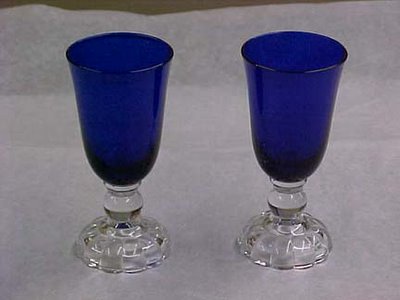Cobalt Gestalt

The craft of the smith ranks immediately after the shaman’s vocation in importance. “Smiths and shamans are from the same nest,” says a Yakut proverb. “A shaman’s wife is respectable, a smith’s wife is venerable,” says another. Smiths have power to heal and even foretell the future. According to the Dolgan, shamans cannot “swallow” the souls of smiths because smiths keep their souls on fire; on the other hand, a smith can catch a shaman’s soul and burn it.
-- Eliade, Shamanism
STONES OF THE SKY -- XXIX
Pablo Neruda
We must speak clearly of the clear stones,
we must speak clearly of the dark stones,
of the ancestral rock, of the blue ray
held prisoner in the sapphire,
of the sculptured boulder in its rough
grandeur, of the wings under water,
of the emerald with its green flame.
Now, then: of the cobblestone
or of the the dazzling marketplace,
the virgin flash of the ruby
or the frozen wave of the coast
or of the secretive obsidian that chose
the negative glow of the shadow:
I, man in decay, ask
from what mother did they come,
from what volcanic sperm,
oceanic, overflowing,
from what flower before, from which scent
snuffed short by the glacial glare?
I am one of those vagabond men
who flying from love are in love
left burned out, broken up
into skin and kisses, into dark
words swallowed by shadow:
I am not ready for so many mysteries:
I open my eyes and see nothing:
I tough the earth and move on,
while flame and flower, scent and water
are changed into clans of crystal,
eternalized in works of light.

Zinc minerals and ores often appear in antiquity and the Middle Ages under the vague and confusing name of cadmia. The Greek writes Dioscorides (ca. AD 40-90) speaks of a cadmium that could be used as a balm; this was zinc oxide. It was formed in copper-smelting furnaces, since zinc is commonly present in copper ore. Later known as calamine, it is still used in medical ointments today.
But there was another kind of cadmia called cobaltum, or kobelt in colloquial German, named after the malevolent goblins that were believed to haunt the mines. The mineral became associated with these unpleasant earth spirits because it was “corrosive,” as Agricola wrote in the Bermannus, eating away at the hands and feet of miners who came into contact with it. Cobalt minerals themselves are harmless enough , but Agrociola’s cobaltum appears to have been a mineral rich in arsenic, probably the cobalt ore smaltite. Cobalt itself was the key component of a blue mineral known as zaffre, from which comes the word “sapphire” (which, however, is not a cobalt compound!). Zaffre was used a a blue glaze for pottery and a coloring agent for blue glass.
-- Philip Ball, The Devil’s Doctor

COBALT SUNSET
Feb. 1, 2006
Who let these dogs out
of their malefic vaults
to jinn the last of day
with this wicked cobalt sky?
It rained; a cool front
was working through; the
sun had died; what remained
was the ravage and wonder
of blue’s hardest fire,
a high ice shot shot
through with gold-silverish
bolts too harshly to
be called beautiful yet
can only be so named,
a Boschean disorder
limned by the coldest delights
afforded by Venus.
Collapsing love spread
like wings to the west,
amped on the soar
of infernal appetites,
a mouth wide open
for desires no sea
of any depth can slake.
A dying wonder, a
naked woman failing into
night, trailing a long
train of catastrophe’s
blue souse, slowly
smoothed over by God’s
hand like a parent tucking
child into bedcovers
of black water til nothing
remains but the faintest
pale blue wattage
too far to the west.
That thus this pour
forever revenant in
cobalt gestalts, eerie
mineralisms salting
the wash of my jones
for sapphire bling,
galloping the facets,
gouting the hue,
way down there,
hollering.

THE HEART OF STONE
Pablo Neruda
Trans. Dennis Maloney
Look,
this
was the heart
of a siren.
Helplessly
hard
she came to the shores
to comb her hair
and play a game of cards.
Swearing
and spitting
among the seaweed.
She was the image
herself
of those
hellish
barmaids
that
in stories
murdered
the weary traveler.
She killed her lovers
and danced
in the waves.
And so,
time passed in
the wicked
life of the siren
until
her fierce
lover, the sailor
pursued her
with harpoon and guitar
through all the seafoam,
farther
than the most
distant archipelagoes,
and when
she reclined
in his arms,
the sailor
gave her
his beveled point,
a final kiss
and a justified death.
Then, from the ship
the dead
commanders
descended,
beheaded
by
that
treacherous
siren,
and with cutlass,
sword,
fork
and knife,
pulled out
the heart of stone
from her chest,
and, near the sea,
it was allowed
to anchor,
in order that
it could teach
the little
sirens
to learn
to behave
properly
with
the
enamored
sailors.

BLUE IN BLUE
Oct 19 2005
Out the hall window
at 2 a.m. my car blares
silver blue and black
in full moonlight.
Wild light bulbs that
midnight blue; the two
are icy blondes writhing
cheek to cheek over the
abyssal mother of all moons,
blueblack and cooing
wave surges toward this shore.
My bluest fantasy
disappears into sex
the way sex fades
into something roaring forward,
a tide maybe, or an age
both newer and older than
any reckoning by saner,
drier, sated Dons. Blonde on
blonde I’m tangled up in
blue in a syzygy of sames,
moon and sea like
heart and sight like singer
and psalm and all halves of
bone in parting delight,
the one melting forever
out of sight, the lucent
gleam of all that remains.
My car in vast moonlight
takes me to a shore
where savage waves pound
wondrous grains now pouring
ineluctably from the window
glass, like a naked woman
walking out a door which closes
in a silver roar of collapsing
wild blue foam. And her eyes
which caught and held me
one in that so pregnant dark --
so blue and silvery with
desire for my blueballed streams,
amid a dark which nailed me
forever to a blueblack tree
of arching fire, evanescent now,
haunting, free, bone on bone
now dreaming of silver’s swoon
in blue, reflecting every sea
which delved the ache and
arch of me to You.


<< Home